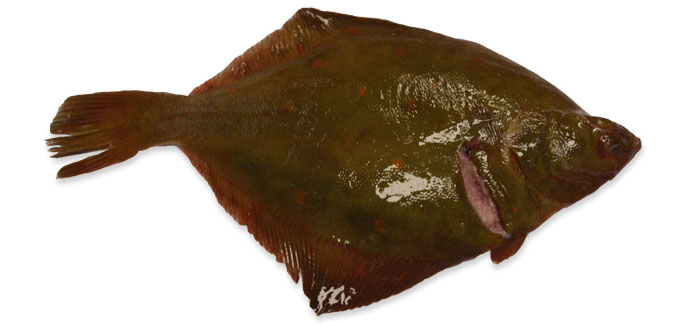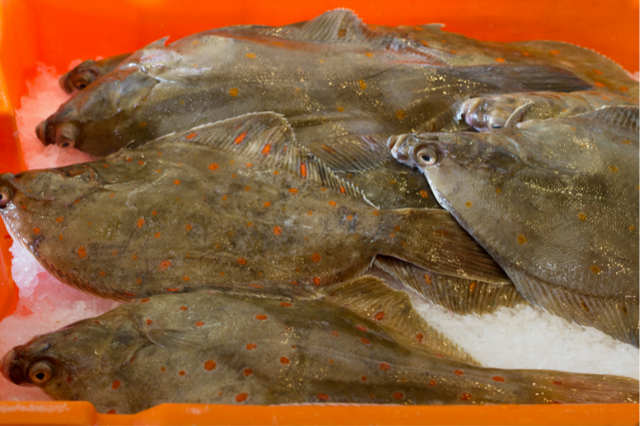Nederlands
English
Deutsch
Français
Fresh plaice is a delicious flatfish that can be prepared as a whole fish (ready to eat) or fillets. Today’s conveniences mean that more and more people are opting for ready-to-eat plaice fillets: no annoying bones to worry about, and the fillets are easy to use in any recipe.
Are you a buyer looking for high-quality fresh (whole) plaice or frozen plaice (ready to cook)?Mooijer-Volendam is a strong and flexible supplier for the catering industry, fishmongers, specialised retailers, and Asian shops. As a fish wholesaler, Mooijer-Volendam also sets high standards for its quality when it comes to fresh fish. Our regular fish suppliers deliver fresh plaice of AAA product quality to our customers several times a week.
Would you like to know more about our fresh and frozen plaice products? This article tells you all about where our plaice comes from, the characteristics of this flatfish and who catches our plaice.
Topics covered in this article include:
Plaice is a diamond-shaped flatfish that belongs to the flatfish and plaice genus (Pleuronectes platessa). Plaice is also related to sole, dab and flounder, and these fish share many similarities.
Plaice is very abundant in the Atlantic Ocean, North Sea, Baltic Sea and the western Mediterranean. Being a flatfish, plaice does not live too far from the coast and live on the seabed, where it can hide well. However, this is not the case with young plaice. Young plaice start life as a ‘regular fish’, with one eye on each side. Just like other fish, they swim freely in the water column.

However, after about six weeks, the plaice undergoes a metamorphosis. One of the eyes develops from the left white side to the right brown side. And now, the plaice slowly changes into a flatfish. It then swims with an undulating motion, the brown side with two eyes always on top. Plaice stay close to the seabed and move forward, covered by the loose sand. They camouflage themselves by imitating the colour of the substrate. This camouflage and its flat shape help it hide very effectively.
Plaice can be caught all year round but is avoided as much as possible in the first months of the year. Plaice are very thin during this period, and this is also their spawning period. Thus, a very important period! From about May onwards, plaice is thicker and more suitable for fishing.
Nowadays, plaice is no longer an endangered fish species and has a green IUCN status. The IUCN is the International Union for Conservation of Nature. Thanks to a properly controlled management plan for plaice, their population in the North Sea is showing a strong upward trend every year. According to biologists’ estimates, there are currently almost one million tonnes of adult plaice swimming in the North Sea (source: ICES 2016 North Sea plaice stock).
Plaice fishing is of enormous economic importance for the Netherlands. Plaice is even one of the most important fish species for the fishing and processing industries. Plaice accounts for almost half of all fresh fish brought to Dutch fish auctions.
In the Netherlands, plaice are caught mainly using innovative pulse fishing gear. Weak current pulses startle flatfish such as plaice and sole from the seabed, causing the fish to swim into the net. There is a square ‘escape hatch’ for other smaller fish just above the opening where the fish enter the net, resulting in little to zero bycatch.
Pulse fishing also ensures significantly less seabed disturbance. Furthermore, boats sail a lot slower than when beam trawling, and pulse fishing is also a lot lighter. As a result, these boats use lightweight engines and less fuel.
Due to the slow fishing speed, another advantage is that plaice and sole catches do not lie twisting in the nets when they are caught. The catch is not taken out of the water in one go, which means no stress for the fish, and they are not harmed or damaged. Plaice that have just come out of the water look perfect and have a well intact mucus layer.
Plaice are immediately sorted by size, gutted, and washed clean on the boat. The plaice is then put into large crates with ice and stored in the refrigerated fish compartments onboard. This way, the plaice stays as fresh as possible.
The fish crates with plaice are ultimately transported within a maximum of four or five days to coastal locations such as Scheveningen and Urk, where the fish are sorted according to size and quality at the fish auction before being transported to suppliers worldwide. The journeys out to sea are kept as short as possible to deliver the product to the auctions as fresh as possible. At Mooijer-Volendam, we only sell AAA quality plaice products.
AAA-quality plaice means a beautiful, thick plaice. The fish still looks fresh and crisp upon arrival. This daily fresh fish is ‘as stiff as a corpse’, as they say: if you hold the fish by its head, the body remains completely straight. Furthermore, the plaice has beautiful, bright orange dots on one greenish-brown side, and the other side is snow-white.
Mooijer-Volendam drives to the fish auction to inspect the freshly caught fish every day. We only buy the fresh fish and offer it to our customers when our experienced buyer is satisfied that the catch meets our quality requirements.
And now the answer to the most important question for you as a buyer: should I buy plaice frozen or fresh?
It all depends on when you want to buy fresh plaice. You can buy responsible fresh plaice from May onwards when the plaice get fatter, and the spawning season is over. The plaice season runs until about November. During this time, sizeable fresh plaice are usually filleted to be sold fresh or frozen as fresh plaice fillets. Smaller fresh plaice are sold whole or frozen, ready to cook. When the weather turns colder, the fat percentage of plaice decreases, and the fish become less tasty.

That is why the frozen plaice is always caught during the correct season and frozen at the best time of the year. When you buy lovely thick frozen plaice, you know for sure that you are buying sustainable plaice. Because plaice is caught and frozen at the correct time of year, it is not only the best and most conscious choice but also the tastiest!
Mooijer-Volendam always guarantees the best quality as we drive to the auction daily to examine the freshly caught fish. If you are a buyer of fresh or frozen plaice, you have come to the right place!
As a fish wholesaler, Mooijer-Volendam sets high standards for its quality. Our customers can rely on AAA product quality, something our customers also demand from us. That is why more and more customers choose us as their wholesale partner in the catering industry or as a wholesaler to fish shops, Asian shops, specialist retailers and large retailers.
Are you curious about our plaice products?